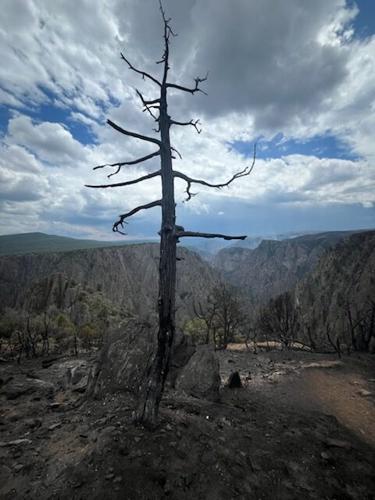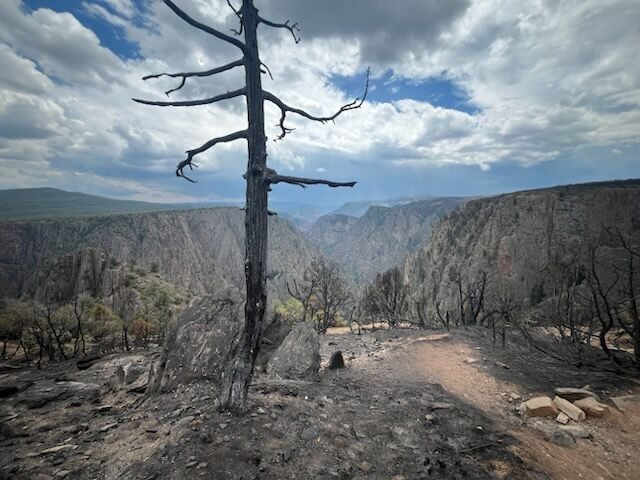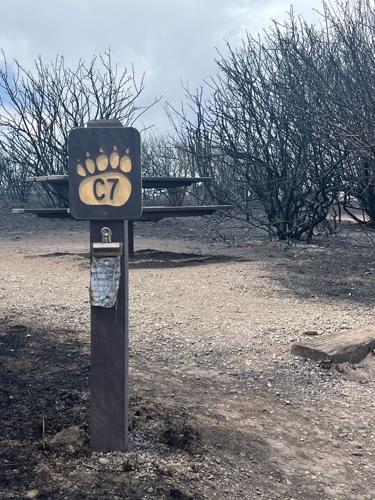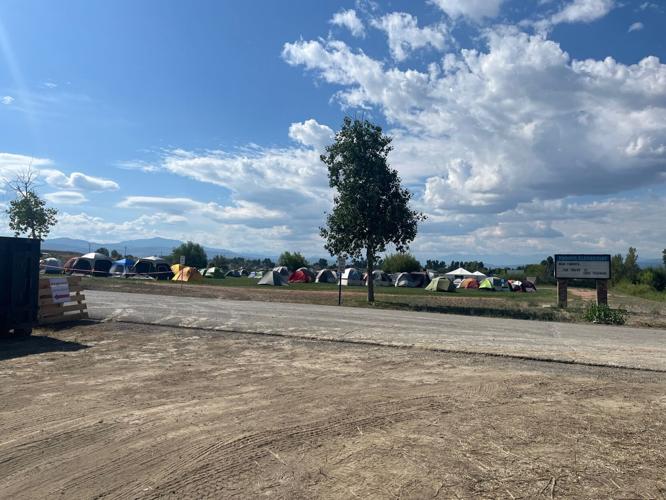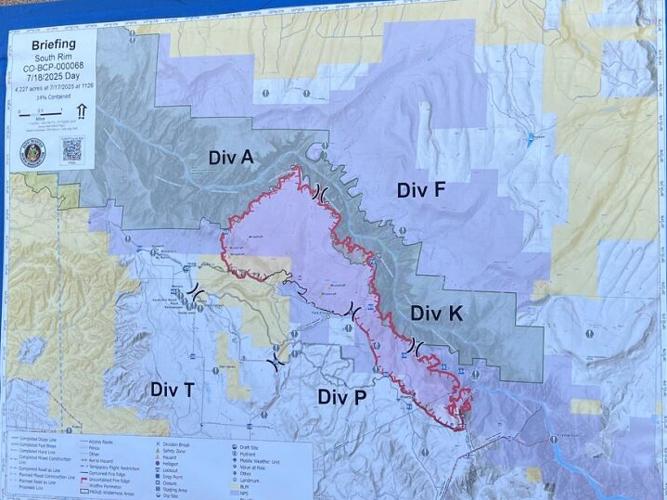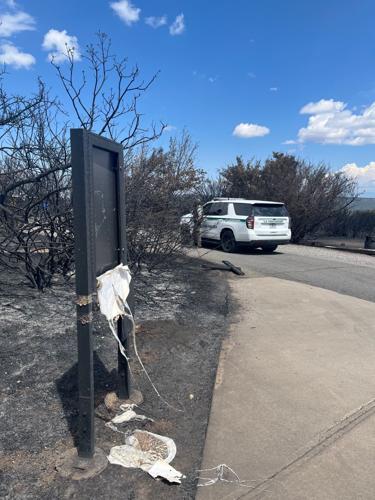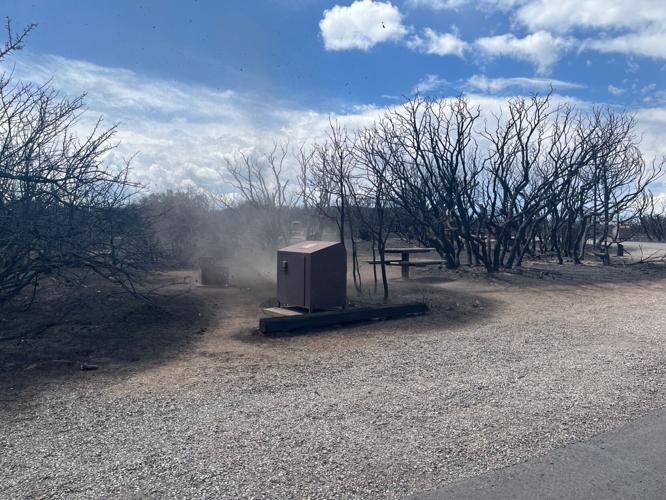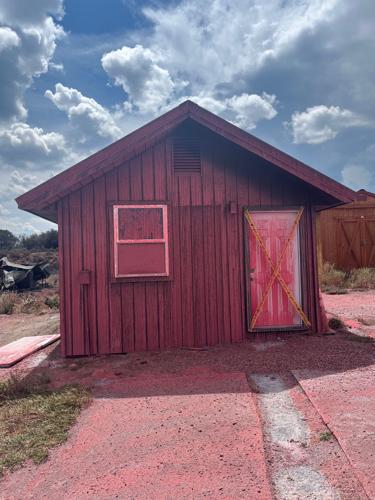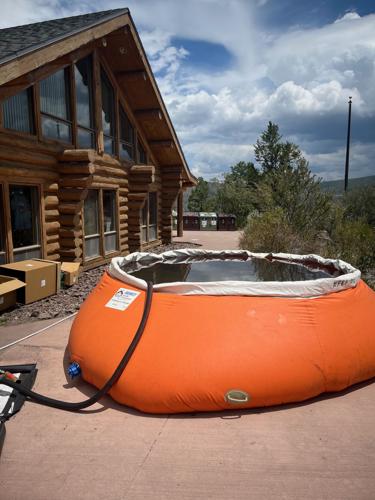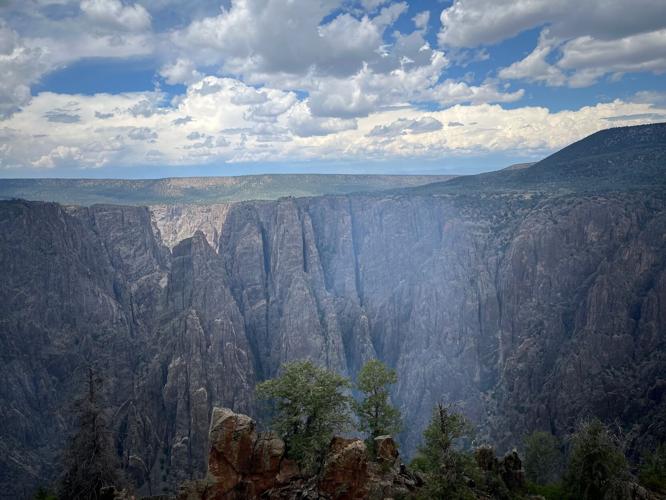South Rim fire at Gunnison National Park only 14% contained
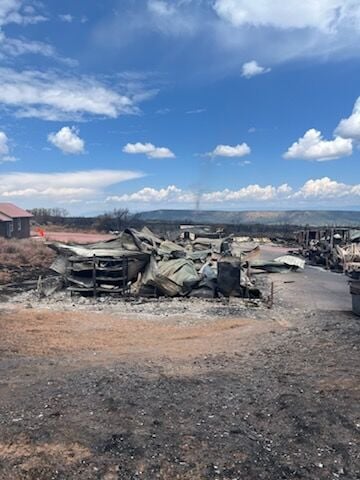
A burned campground at the Black Canyon of Gunnison National Park, near Montrose, Thursday, July 18, 2025. The South Rim fire has burned more than 4,227 acres and was only at 14% containment, according to the Rocky Mountain Complex Incident Team 3. (Credit: Rachael Wright/Special to The Denver Gazette)
Rachael Wright/Special to The Denver Gazette
Early the morning of July 10, a dry lightning storm moved across southwestern Colorado and ignited 10 fires — three in the Black Canyon of the Gunnison National Park, near Montrose.
Bureau of Land Management’s firefighters were able to swiftly contain all but one of the fires, according to Park Superintendent Stuart West who helped lead of media tour of the burn area Thursday.
Red Flag conditions and dry fuels meant the single fire spread incredibly rapidly. Within two-and-a-half hours the national park was evacuated and the few park visitors who were in the wilderness were located and evacuated.
The initial attack of the South Rim fire was at-first fought by local agencies. But the fire swiftly became more complex, and the Rocky Mountain Complex Incident Team Number 3 deployed from Durango. Not only was the fire complex, burning the rim of the canyon and creeping down the drop-offs — but it threatened a host of high-value community resources.
“It was quickly obvious that it was going to grow beyond the capabilities of the responding resources,” said one of the first responders, Rusty Stark, district Fire Management officer for BLM Colorado Southwest District in Montrose. “We focused on life safety and the evacuation of the park and doing structure protection rather than suppression.”
The RMCIT Number 3 brought with them 457 personnel including five aircraft, eight crews, 22 engines and 15 heavy equipment vehicles. Critical Incident Teams are vital to complex fires because they work with large fires all summer and have specialists trained to handle all aspects of firefighting, including a three-pronged Public Information Office comprising of media outreach, communications and office branches.
With the use of an IPAWS (Integrated Public Alert & Warning System) Alert and door-to-door canvassing with the assistance of the Montrose County Sheriff’s Department, more than 90 homes and 40 commercial buildings were evacuated, amounting to nearly 200 people. Vacant leases on BLM land meant that very few cattle or ranchers were particularly at risk and no loss of life has been reported.
As of Thursday, 80% of visitor-use areas at the Black Canyon of the Gunnison National Park have been consumed. Due to quick work by the Structure Protection Group, fire lines and a sprinkler system were hastily assembled, and the visitor center was saved. The dual bathrooms glowed pink in the bright sunshine Thursday, covered with retardant.
Near the still-intact visitor center, an entire campground was consumed. All that’s left are the metal posts of the picnic tables, fire pits and a few camp site signs, the trees are black against a strangely clear sky. Across the park as a whole only 12% is burned. As of Thursday afternoon, RMCIT reported 14% containment.
As fire suppression is ongoing crews make use of hand tools and heavy equipment to strengthen fire lines on the northwest, west and southwest portions of the fire area. Drones were also used to drop precision ignition spheres or “dragon eggs.” Ignition spheres contain potassium permanganate and before being dropped glycol is injected into the spheres. Within a minute of hitting the ground the sphere ignites and draws the fire toward where firefighters can work safely and efficiently to put it out.
The cost of the fire has already risen to $6.2 million, according to Montrose County’s Emergency Management Manager Scott Hawkins. Because so many different jurisdictions are affected by the fire, the cost is shared amongst the federal, county, and private landowners. What is particularly difficult for the county is the closure of the National Park, which injects $32 million annually in the local economy.
“The economic impact of this park being closed is something that we have talked about,” Hawkins said. “There is going to be a financial impact that we are talking about with consequence management. We signed a county disaster declaration, not only for funds, but also for resource that the county can use for recovery.”
Along with 4,227 acres of land already burned, the Crystal and Diversion Dams are at particular risk for post debris flow and water quality due to contamination of ash tumbling down the Gunnison River and harming delicate fish populations.
“We are working hard with the Bureau of Land Management to keep ash out of the River,” Hawkins said.
Of vital interest as well is the delicate habitat of the Gunnison Sage-Grouse located across the canyon from the visitor center. The species is classified as unique and are federally threatened and endangered within the state.
While Jay Miller, deputy incident commander for Rocky Mountain Complex Incident Team Number 3, says that the fires are likely to burn for a few more weeks in the inaccessible canyon, there is hope for renewal and regeneration for the land. The federally funded Burned Area Recovery Team will be on hand to address the future of the devastated areas.
Although the fires cost strapped rural economies millions of dollars, fires can create opportunities for new species to thrive as plants are not competing against already mature trees for limited sunlight and water. Leaving the park, a deer was seen grazing on the undamaged vegetation and birds have already returned.
First responder Stark said that there wasn’t just one instance of heroism among his crew.
“Everything everyday what these guys do out on the ground is heroic,” Stark said. “Most people don’t know the amount of work that these wild-land firefighters put out on a daily basis. It’s really incredible.”
For More Information and to stay up to date go to: South Rim Fire Information Facebook Page.








